Abstract
In alignment with the United Nations’ Sustainable Development Goals (SDGs) and the global pursuit of net-zero emissions, higher education institutions (HEIs) are increasingly expected to demonstrate robust climate accountability and effective decarbonization strategies. This three-year longitudinal study presents a comprehensive assessment of greenhouse gas (GHG) emissions at a higher education institution, employing the ISO 14064-1:2018 framework to strengthen inventory design, boundary delineation, and data governance protocols. Findings indicate that purchased electricity constitutes the largest share; however, fugitive refrigerant leakage and Scope 3 activities—particularly commuting and business travel—represent substantial and often underestimated components of the institution’s carbon footprint. Methodological refinements, including the incorporation of updated emission factors coefficients and enhanced data verification, have revealed the sensitivity of GHG inventories to both policy reforms and behavioral changes, as well as institutional policy reforms. The study also demonstrates that targeted refrigerant management and low-carbon mobility initiatives can generate measurable mitigation effects, even under conditions of expanding campus activity. Beyond the institution-specific results, this research proposes a replicable framework that integrates ISO 14064-1 compliance with data quality assurance and digital verification tools. This framework provides HEIs globally with a structured pathway to enhance reporting credibility, develop evidence-based mitigation strategies, and accelerate progress toward carbon neutrality. These insights underline the strategic role of universities in advancing sector-wide climate leadership and contributing to sustainable development transitions.
1. Introduction
The accelerating pace of global warming and the escalating impacts of climate change have intensified the call for rapid decarbonization across all sectors of society. Higher education institutions, as both intellectual hubs and large-scale organizations, are increasingly recognized as critical actors in advancing climate action, not only by shaping future leaders and research agendas, but also by directly reducing their operational carbon footprints [1,2]. In response to national and international policy frameworks, including the Paris Agreement and the United Nations’ Sustainable Development Goals (SDGs), as well as national net-zero commitments, universities worldwide are developing comprehensive greenhouse gas (GHG) inventories and transitioning to carbon-neutral campuses [3,4].
Recent years have witnessed a paradigm shift in the scope and rigor of campus carbon management. Traditional inventories, often limited to direct emissions (Scope 1) and purchased electricity (Scope 2), have proven insufficient for accurately capturing the full climate impact of university operations [5]. Increasingly, there is a mandate to expand reporting boundaries to encompass indirect, activity-driven emissions (Scope 3), such as those from employee commuting, business travel, supply chains, and waste management. This broader approach not only aligns with the principles of organizational accountability and transparency but also uncovers critical, previously underestimated mitigation opportunities [6].
International standards, particularly ISO 14064-1:2018 [7], have emerged as essential frameworks for ensuring the consistency, credibility, and comparability of GHG inventories in the education sector. ISO 14064-1 provides rigorous guidance on the quantification, reporting, verification, and continuous improvement of an organization’s GHG emissions, thereby supporting transparent and science-based climate action [7]. Its adoption enables universities to institutionalize robust data governance, set science-based targets, and benchmark progress against both peer institutions and global best practices [8]. Alongside ISO standards, protocols such as the Greenhouse Gas Protocol [9] and sector-specific sustainability charters underscore the importance of transparent carbon accounting. Recent research highlights that integrating ISO-based inventories with broader institutional sustainability frameworks significantly enhances mitigation planning, stakeholder engagement, and regulatory compliance in higher education contexts [10,11].
Taiwan’s higher education system has responded proactively to these trends, underpinned by policy directives from the Ministry of Education and the national Sustainable Campus Promotion Plan, which, since 2007, has mandated regular GHG inventories, the implementation of energy management systems, and the public disclosure of environmental performance. Asia University (AU), the focus of this study, exemplifies institutional climate leadership through its early adoption of international management standards, having obtained certifications for ISO 14001, ISO 50001, and ISO 45001 [12]. Its ongoing investments in campus sustainability are underscored by a 2025 third-party environmental assessment, which confirms that AU’s green coverage reached an impressive 97.2%, signaling a strong commitment to operational excellence and ecological stewardship [13].
Despite such achievements, the path toward campus decarbonization is fraught with challenges. Methodological issues—such as emission factor variability, boundary definitions, and data collection gaps—can undermine the reliability of inventories and obscure real progress [14,15]. Furthermore, emerging sources of emissions, including those linked to behavioral shifts such as remote work, increased travel, and digitalization, must be captured through innovative monitoring and management systems [16,17].
This study presents a comprehensive, three-year organizational GHG inventory at AU, conducted in strict accordance with ISO 14064-1:2018 [7]. The research encompasses all major emission scopes and categories, rigorously assesses data quality and uncertainty, and incorporates the most current national emission factors [18]. By analyzing emissions trends, inventory structure evolution, and the effectiveness of targeted mitigation measures—including energy efficiency upgrades, refrigerant management, and low-carbon mobility strategies—this work advances both methodological rigor and practical solutions for the sector [19,20].
By embedding ISO 14064-1 principles into the operational and cultural fabric of the university, this study demonstrates not only the feasibility but also the strategic value of transparent, science-based carbon management in higher education [21,22]. The findings offer actionable insights and a scalable blueprint for universities worldwide, aiming to accelerate the sector’s transition toward carbon neutrality, regulatory compliance, and global climate leadership [4,23].
Recent advances in campus GHG accounting reveal persistent blind spots in Scope 3 coverage, refrigerant leakage quantification, and data governance that limit comparability and mitigation prioritization across HEIs [5,6,7,8,11,12,13,14]. Building on these gaps, this study contributes by (i) delivering the first Taiwan-based, multi-year (2021–2024) ISO 14064-1:2018–compliant organizational inventory within an HEI; (ii) quantifying how emission-factor revisions (e.g., refrigerants, LPG) and activity-data corrections (commuting, business travel) reorder category contributions and mitigation priorities; and (iii) operationalizing a replicable governance and verification pipeline (materiality ≥ 3%, Monte-Carlo uncertainty propagation, third-party checkpoints) that is transferable beyond HEIs [9,10,11,12,13,14,20]. Collectively, these elements move beyond descriptive audits by integrating uncertainty, sensitivity, and governance design, thereby strengthening the evidentiary basis for ISO-aligned target-setting and investment decisions in higher education and other public estates [5,7,8,9,10,11,14,21].
The remainder of this paper is organized as follows. Section 2 describes the ISO 14064-1–aligned research design, boundary definition, data governance, and procedures for uncertainty and materiality. Section 3 presents the multi-year results, including sensitivity to changes in emission factors and category-level drivers. Section 3 discusses transferability beyond HEIs and managerial implications. Section 4 concludes with limitations and directions for future research.
2. Research Methods
2.1. Framework and Boundary Definition
We adopt 2021 as the methodological baseline for three reasons: (i) 2019–2020 were transition years characterized by pandemic disruptions and only partial ISO 14064-1 implementation; (ii) beginning in 2021, an identical operational-control boundary, category taxonomy, ≥3% materiality rule, and third-party verification gates were applied consistently; and (iii) key Scope 3 classes (employee commuting, business travel) were incorporated from 2022 using stable methods, yielding a coherent 2021–2024 longitudinal series suitable for trend testing and uncertainty analysis [5,7,11,14]. The operational control approach was employed to define the inventory boundary, systematically including all facilities, activities, and assets under the university’s direct control, consistent with best practices in campus carbon accounting [5,19]. The scope encompasses all teaching, administrative, residential, and public service buildings at the main campus in Wufeng District, Taichung City. Facilities not directly managed by the university—such as outsourced restaurants and convenience stores—were excluded to avoid boundary ambiguity and prevent double-counting.
Emission sources were categorized by ISO 14064-1:2018 into six primary classes: (1) direct emissions from stationary combustion, mobile combustion, process activities, and fugitive sources; (2) indirect emissions from purchased electricity; (3) indirect emissions from transportation, including employee commuting and business travel; (4) indirect emissions from the consumption of products (e.g., paper, IT equipment, fuel, and water); (5) indirect emissions from the use of organizational assets (e.g., leased facilities); and (6) other relevant indirect emissions not currently inventoried but potentially significant to the institution’s climate impact [6].
2.2. Data Collection, Management, and Quality Assurance
A multi-tiered data collection protocol was implemented to ensure both completeness and accuracy, in line with best practices for organizational GHG inventories in higher education institutions [5,19]. Each functional department was tasked with systematically recording resource consumption—including electricity, fuels, water, refrigerants, and waste—on at least a monthly basis. Data flows were centralized through the Environmental Safety Office, which acted as the primary hub for data validation and cross-departmental reconciliation. Key data streams included utility invoices, on-site meter readings, equipment inventories, travel logs, and procurement records, ensuring a comprehensive representation of both direct and indirect emissions [10].
Fugitive emissions from refrigerants—a critical and frequently underestimated category in campus carbon inventories—were estimated by combining equipment inventory records with the most recent emission factors issued by national authorities. Leakages and system replacements were tracked via maintenance logs, while periodic equipment audits ensured that the database remained aligned with the actual operational status of assets [11,18].
To safeguard data integrity, multiple quality control measures were embedded into the process: (i) double-entry validation for all critical figures; (ii) scheduled internal audits and inter-departmental cross-checks; (iii) flagging of outliers or missing data for immediate follow-up; and (iv) routine updates to emission factors by the latest regulatory releases [9]. The adoption of digital monitoring tools and data management software has further enhanced traceability, transparency, and long-term record-keeping, facilitating continuous improvement in alignment with the principles of ISO 14064-1:2018 [16].
2.3. Uncertainty, Materiality, and Significance Assessment
Recognizing the importance of methodological transparency and continuous improvement, the inventory process incorporated formal uncertainty and materiality assessments as prescribed by ISO 14064-1:2018 [7]. Uncertainty analysis was conducted using both quantitative and qualitative approaches, in alignment with established best practices for GHG accounting in higher education and corporate contexts [5,14]. Quantitatively, uncertainty propagation was estimated for each key emission category by integrating the reported variability in activity data and emission factors [11,18]. Qualitative assessments considered risks of systematic bias, data gaps, and evolving operational practices that could affect inventory completeness and comparability over time [10].
Materiality evaluation followed a two-step process: first, identifying emission sources contributing more than 3% of the total organizational footprint; and second, applying expert judgment to include additional sources with high policy relevance or mitigation potential, even if their current share was smaller [8,21]. Significant categories identified through this process were prioritized for enhanced monitoring, targeted data quality improvements, and, where applicable, third-party verification to ensure the robustness and credibility of the inventory [16].
2.4. Statistical and Uncertainty Procedures
We assessed trend significance using the Mann–Kendall test (α = 0.05) with Theil–Sen slope estimates for scopes and key categories (2021–2024). Uncertainty propagation applied a 10,000-run Monte-Carlo simulation combining activity-data variance and emission-factor ranges to derive 95% confidence intervals (CIs) at category and total levels. Sensitivity analyses varied refrigerant (+/−10%) and LPG (−5%) factors to quantify impacts on totals and the ranking of categories. For commuting surveys, stratified weighting by staff groups mitigated sampling bias, and bootstrap CIs were computed for key contrasts [5,7,11,14].
2.5. Emission Factor Selection and Methodological Updates
To ensure consistency and comparability, the study utilized the most current, jurisdiction-approved emission factors, which are updated annually in accordance with national regulatory guidelines [18]. In cases where local emission factors were unavailable, internationally recognized and peer-reviewed sources—such as the IPCC Guidelines and the GHG Protocol—were applied to maintain methodological robustness [9,11]. All methodological updates, including revisions to emission factor values and changes in activity data definitions, were transparently documented in line with best practices for ISO 14064-1 implementation [7], with explicit notation of their anticipated influence on year-to-year comparability [5,14].
2.6. External Review and Continuous Improvement
The inventory process underwent periodic third-party verification by accredited environmental consultants, ensuring conformance with ISO 14064-1:2018 requirements and alignment with sectoral best practices for higher education GHG accounting [7,11]. External audits emphasized the robustness of organizational boundary definitions, the accuracy and traceability of key activity data streams, and the transparency of methodological decisions, in line with recommendations from prior university carbon management studies [5,14]. Feedback from these independent reviews informed iterative improvement cycles, including the deployment of upgraded monitoring systems, targeted capacity building, and cross-departmental training programs [10].
All data collection and reporting procedures adhered to institutional ethical guidelines and applicable data privacy regulations [12]. Stakeholder engagement processes—spanning consultations with facility managers, academic units, and student organizations—ensured that inventory boundaries, methodological assumptions, and prioritization strategies were both socially robust and aligned with the university’s overarching sustainability mission [1,2,3].
3. Results and Discussion
3.1. Comparative Analysis of GHG Emission Trends (2021–2024) Under ISO 14064-1
Table 1 presents a structured, multi-year comparison of greenhouse gas (GHG) emissions at Asia University (AU), conducted in accordance with the ISO 14064-1:2018 standard. The inventory encompasses all three emission scopes, as well as key subcategories such as fugitive emissions, employee commuting, and business travel, thereby enabling detailed tracking of an organization’s carbon performance. From 2021 to 2023, AU’s total GHG emissions increased steadily from 7606.51 to 11,343.00 metric tons CO2e (tCO2e), representing an overall rise of 49.1%. This upward trend was primarily attributable to enhanced boundary definitions—most notably the inclusion of Scope 3 emissions beginning in 2022—improvements in data accuracy, and a rebound in campus activity following the COVID-19 pandemic. In 2024, a slight decrease to 10,365.79 tCO2e signaled an initial stabilization of emissions, potentially driven by improved data governance and the early effects of mitigation strategies.

Table 1.
Annual greenhouse gas emissions by scope and source at AU (2021–2024): differences and trends.
To ensure compliance with ISO 14064-1:2018, the multi-year emissions data were analyzed across Scope 1, Scope 2, and Scope 3, and further disaggregated by major source categories. This analysis is complemented by two comprehensive visualizations (Figure 1 and Figure 2): Figure 1 depicts trends in GHG emissions by scope from 2022 to 2024, reflecting the evolution of AU’s carbon profile under full ISO 14064-1 coverage, while Figure 2 illustrates annual emission compositions by category from 2021 to 2024, underscoring the increasing importance of indirect and behavior-driven sources.
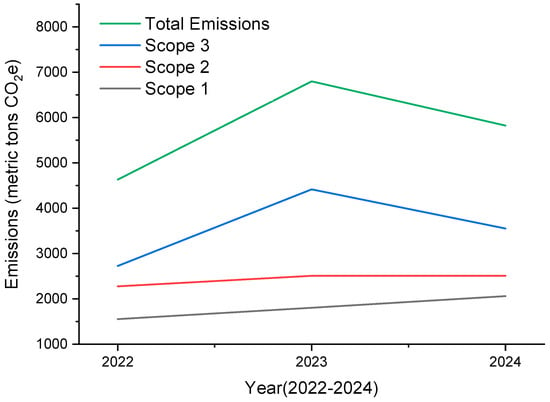
Figure 1.
Annual GHG emissions by scope, 2021–2024; 2021 baseline included; error bars = 95% CIs (10,000-run Monte Carlo).
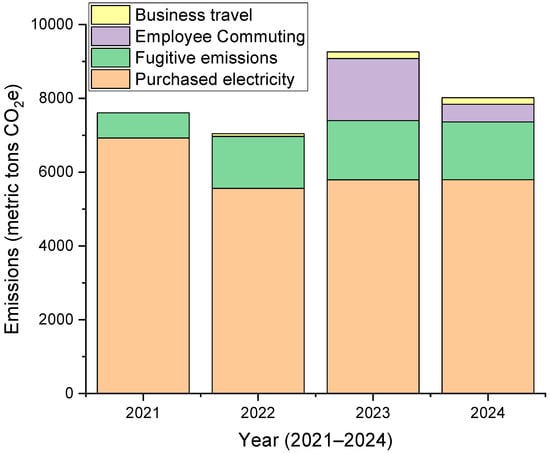
Figure 2.
Annual emission composition by category (2021–2024), highlighting the rising significance of indirect and behavior-driven emission sources.
Notably, Scope 1 emissions increased substantially due to fugitive refrigerant leakage, peaking at 1803.15 tCO2e in 2023 before declining slightly in 2024 as a result of improved equipment management. Scope 2 emissions (purchased electricity) remained stable at approximately 5791–5795 tCO2e, continuing to represent the largest share of the emissions inventory. Scope 3 emissions exhibited the most significant year-to-year variability, driven primarily by fluctuations in commuting and business travel.
The rising share of Scope 3 and fugitive emissions highlights both the increasing sophistication of AU’s inventory management practices and the inherent limitations of legacy reporting approaches used before 2022. These findings support the adoption of targeted mitigation measures, such as enhancing energy efficiency and expanding the use of renewable energy. To further strengthen GHG performance and ISO 14064-1 compliance, the university is advised to institutionalize rigorous data verification procedures, conduct regular equipment audits, and closely align emission reduction initiatives with broader sustainability strategies.
3.2. Impact of Emission Factor Revisions on GHG Inventory Accuracy (2023–2024)
Table 2 summarizes the emission factor updates adopted by the ISO 14064-1:2018 standard, which requires organizational greenhouse gas (GHG) inventories to incorporate the most current and jurisdiction-approved emission coefficients. In 2024, Taiwan’s Ministry of Environment released revised emission factors for several key sources, significantly affecting AU’s GHG calculations across various categories. These changes influenced not only absolute emissions but also the relative contributions of each source category. Figure 3 illustrates the percentage change in emission factors from 2023 to 2024, highlighting the most substantial adjustments observed in liquefied petroleum gas (LPG) and fugitive emissions (refrigerant leakage), with a 5% decrease and a 10% increase, respectively.

Table 2.
Year-on-year changes in greenhouse gas emission factors by source (2023 vs. 2024).
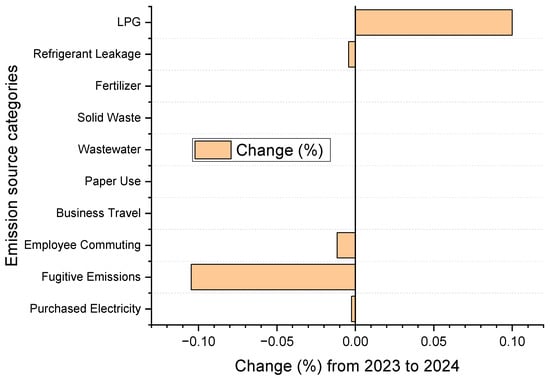
Figure 3.
Percentage change in emission factors by source category (2023–2024).
The emission factor for refrigerant leakage increased from 1300 to 1430 kg CO2e/kg—an increase of 10%. This adjustment had a pronounced effect on Scope 1 emissions, particularly in facilities equipped with aging HVAC systems. The revision aligns with global trends toward updating global warming potential (GWP) values and enforcing stricter regulations on fluorinated gases. Notably, this change resulted in increased reported emissions despite no significant variation in refrigerant consumption, underscoring the sensitivity of Scope 1 accounting to regulatory updates.
Conversely, the emission factor for LPG was reduced by 5%, likely reflecting improved combustion efficiency or updated assumptions regarding fuel calorific values. While the overall effect on total emissions was minor, this adjustment highlights the impact of refined local fuel modeling on inventory outcomes, particularly in kitchen and laboratory operations under Scope 1. Although no changes occurred in travel-related emission factors (e.g., for gasoline and diesel), more accurate data on commuting behavior and travel distances led to an indirect rise in associated emissions. This represents data-driven growth rather than methodological change, primarily affecting Scope 3 emissions.
The emission factor for purchased electricity remained constant at 0.502 kgCO2e/kWh, indicating stability in Taiwan’s national grid energy mix during this period. However, any future increase in renewable energy integration will directly affect this factor’s role in Scope 2 emissions.
No changes were observed in the emission factors for business travel or paper usage. Accordingly, variations in their emissions between 2023 and 2024 can be attributed entirely to fluctuations in activity levels rather than coefficient adjustments. Although sources such as wastewater, fertilizer, and solid waste are not currently included in AU’s primary inventory, the observed change in wastewater emissions (approximately −2.5%) suggests ongoing refinements in GHG modeling—potentially involving methane recovery mechanisms—and signals the importance of preparing for broader Scope 3 integration.
Therefore, the inventory system is increasingly sensitive to both emission factor adjustments and improvements in activity data. Source categories with significant year-over-year changes—particularly refrigerants and LPG—should be prioritized for third-party verification. To ensure transparency and comparability, institutions must continuously track national emission factor updates and maintain backward-compatible documentation. The updated refrigerant emission factor further highlights the urgency of transitioning to low-GWP alternatives, enhancing leak detection systems, and upgrading outdated equipment to support institutional decarbonization strategies.
3.3. Refrigerant Fugitive Emissions: Trend Analysis and Inventory Implications (2022–2024)
Table 3 and Figure 4 present a multi-year analysis of refrigerant-related fugitive emissions at AU, conducted in accordance with ISO 14064-1:2018 requirements for organizational GHG inventories. This assessment integrates three key metrics: total refrigerant emissions, the number of refrigerant-containing equipment units, and the average emissions per unit.

Table 3.
Annual refrigerant fugitive emissions, equipment counts, and per-unit emissions at AU (2022–2024).
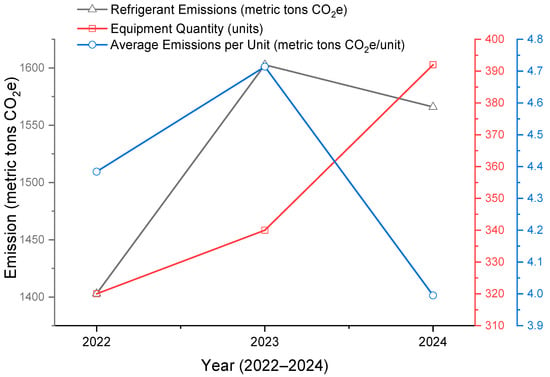
Figure 4.
Refrigerant fugitive emissions, unit counts, and per-unit averages, 2021–2024. Shaded band = 2023→2024 factor revision; error bars = 95% CIs. Between 2022 and 2023, total refrigerant fugitive emissions increased substantially from 1402.96 to 1602.74 tCO2e (+14.2%), accompanied by a moderate rise in equipment units (from 320 to 340, +6.3%). The average emissions per unit likewise increased, from 4.38 to 4.71 tCO2e/unit, indicating that both inventory expansion and methodological updates—such as revised emission factors—contributed to higher reported emissions.
A notable shift occurred in 2024: the number of refrigerant units rose sharply by 15.3% (from 340 to 392), yet total refrigerant emissions declined slightly to 1565.93 tonnes of CO2 equivalent. Most significantly, the average emissions per unit decreased markedly to 3.99 metric tons of CO2e per unit. As illustrated in Figure 4, this decoupling of equipment growth from per-unit emissions underscores the effectiveness of targeted refrigerant management interventions.
The initial increase in emissions from 2022 to 2023 reflects both the expansion of equipment inventories and the adoption of updated national emission factors, consistent with ISO 14064-1’s emphasis on completeness and methodological rigor. By contrast, the substantial reduction in per-unit emissions in 2024—despite further growth in equipment count—suggests that enhanced leak detection, improved maintenance protocols, and the partial adoption of low-GWP refrigerants have begun to yield measurable mitigation outcomes. This progress aligns with the requirements of ISO 14064-1 for continual improvement and demonstrable mitigation actions.
It is essential to note that trends in Scope 1 fugitive emissions are susceptible to both activity data (such as equipment counts) and methodological changes (such as updates to emission factors). Therefore, robust documentation and transparent, year-over-year comparisons are crucial for maintaining the credibility of the GHG inventory. As asset registers are refined, organizations should anticipate initial increases in reported emissions, followed by reductions as management improvements take effect. Sustained reductions in Scope 1 emissions will require prioritizing regular maintenance, systematic upgrades, and the adoption of low-GWP refrigerants. Given the volatility and policy significance of fugitive emissions, third-party verification should routinely review refrigerant management records and the calculation methodologies used to ensure accuracy.
Figure 4 trends in total refrigerant fugitive emissions, number of equipment units, and average emissions per unit (2022–2024). The Figure illustrates that, following initial increases in both emissions and equipment numbers, the implementation of effective management strategies led to a notable reduction in average per-unit emissions in 2024, despite the continued expansion of the inventory.
3.4. Evaluation of Business Travel Emissions and Systematic Mitigation Opportunities
Table 4 summarizes the annual GHG emissions from business travel at AU from 2022 to 2024. Emissions rose sharply from 71.08 tCO2e in 2022 (the baseline year) to 180.02 tCO2e in 2023—a 153.1% increase that coincided with the resumption of academic travel following the COVID-19 pandemic. In 2024, emissions remained at this elevated level, indicating the establishment of a new post-pandemic equilibrium in institutional mobility practices.

Table 4.
Annual business travel emissions and percentage Change at AU (2022–2024).
Although business travel accounts for a moderate share of the university’s total GHG emissions, its pronounced year-on-year variability underscores the impact of campus policies and evolving academic engagement models. This volatility underlines the necessity for targeted mitigation strategies. Figure 5 presents a comparative analysis of the effects and feasibility of various GHG mitigation measures on campus. The results identify renewable energy expansion and energy efficiency improvements as the most promising options, each offering substantial emission reductions (exceeding 500 tCO2e and 450 tCO2e per year, respectively) and scoring above 4.5 out of 5 in implementation feasibility. Additionally, commuting carbon management and refrigerant management optimization emerge as significant, actionable levers, while enhancing campus carbon sinks (e.g., through tree planting) provides moderate but meaningful additional capacity.
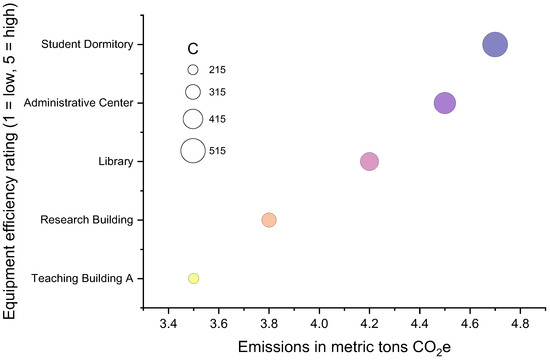
Figure 5.
Relationship Between Building Equipment Efficiency Ratings and CO2e Emissions.
Figure 6 illustrates the evolution of AU’s GHG emission profile by scope from 2021 to 2024. The area chart shows a decrease in the relative share of Scope 2 emissions (purchased electricity) and a corresponding increase in Scope 3 emissions, primarily due to the expansion of data collection for commuting and business travel. This trend highlights the growing significance of behavior- and activity-based emissions sources as the inventory system becomes more comprehensive and mature.
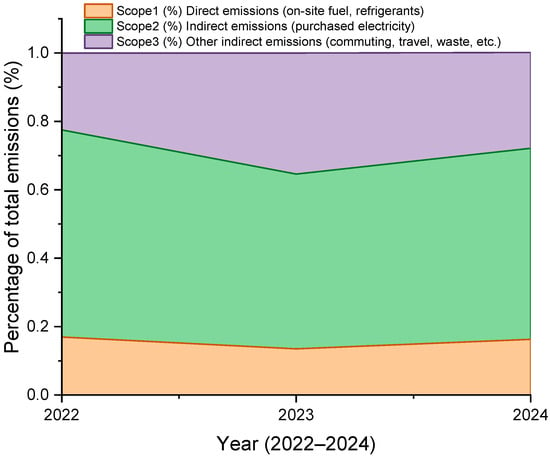
Figure 6.
Impact potential and feasibility analysis of campus GHG mitigation measures, highlighting priority actions for decarbonization.
Taken together, the results reveal several key insights. First, business travel emissions exhibited a sharp post-pandemic rebound followed by stabilization, reflecting the responsiveness of institutional GHG profiles to policy and operational changes. Second, the mitigation impact analysis (Figure 6) reinforces the importance of prioritizing interventions with high impact and feasibility—especially renewable energy adoption, energy efficiency measures, and improved mobility management—while recognizing the value of sustained investments in natural carbon sinks. Third, the evolution of the inventory structure (Figure 6) demonstrates that as data quality and coverage expand, the prominence of indirect, activity-driven emissions (Scope 3) increases, necessitating innovative strategies and cross-sector collaboration to achieve holistic decarbonization.
Although this framework was developed and validated within a university setting, its design can be easily adapted for use in other public institutions, such as hospitals, research centers, and government campuses. These institutions share similar operational structures, including multi-building estates and HVAC-intensive loads, as well as dominant emission categories like purchased electricity and refrigerants. They also face comparable data governance challenges, such as managing distributed meters, commuting and travel activity data, and outsourced services. Utilizing ISO 14064-1 as a foundational framework, the process of defining boundaries, conducting materiality screenings (≥3%), and implementing uncertainty and verification procedures can be applied to non-higher education institution (HEI) estates with minimal modifications. For instance, patient and visitor flows can be substituted for student mobility in hospitals, while municipal campuses can focus on fleet and facility portfolios. Additionally, aligning with the GHG Protocol allows for benchmarking against the reporting practices of city governments and healthcare organizations. This alignment enhances the cross-sector comparability of scope 1–3 profiles, supporting the development of portfolio-level decarbonization roadmaps and procurement policies.
In summary, AU’s experience demonstrates that continuous refinement of inventory boundaries, proactive implementation of high-impact mitigation strategies, and systematic monitoring of both direct and indirect emission sources are essential components of effective organizational GHG management under ISO 14064-1. These findings offer a practical framework for other higher education institutions aiming to meet international standards for GHG inventory and sustainability performance.
4. Conclusions
Applying ISO 14064-1:2018 enables higher education institutions to quantify, track, and manage greenhouse gas (GHG) emissions with rigor and comparability. Across three inventory years, purchased electricity (Scope 2) and fugitive refrigerants (Scope 1) remain the dominant contributors to the institutional footprint, while Scope 3 sources—especially commuting and business travel—gain prominence as data quality and boundary coverage improve. To strengthen GHG governance, universities should (i) routinely update organizational boundaries and activity datasets, (ii) institutionalize independent third-party verification, and (iii) prioritize high-yield actions: expanded renewable procurement, end-use energy efficiency, and advanced refrigerant management (leak detection, low-GWP transitions). Targeted mobility policies (e.g., telepresence, modal shift incentives, carbon budgeting for travel) are crucial for curbing Scope 3 growth. Institutions should also track emission-factor revisions, deploy digital MRV (metering, refrigerant tracking, automated data pipelines), and prepare for evolving carbon policies and markets. Future work will: (1) develop department-level marginal abatement cost curves (MACCs) to sequence measures by cost-effectiveness; (2) quantify the accuracy and labor benefits of IoT-enabled MRV; (3) expand coverage toward procurement-driven Scope 3 and site-level LCA; and (4) test policy scenarios (renewable grid shares, f-gas regulation, carbon pricing/CBAM) to stress-test mitigation roadmaps. Overall, the systematic implementation of ISO 14064-1 provides a robust and scalable template for universities to accelerate progress toward carbon neutrality and sector-wide climate leadership.
Author Contributions
Conceptualization, S.-P.Y. and G.J.T.; Methodology, S.-Y.T., S.-P.Y. and C.-P.L.; Formal analysis, S.-P.Y. and C.-P.L.; Investigation, C.-P.L.; Data curation, S.-Y.T., M.-C.W. and S.-P.Y.; Writing—original draft, S.-Y.T.; Writing—review & editing, C.-P.L.; Project administration, C.-P.L. All authors have read and agreed to the published version of the manuscript.
Funding
This research was funded by the National Science and Technology Council (NSTC), grant number NSTC 113-2636-H-468-001-. The APC was funded by the National Science and Technology Council (NSTC).
Institutional Review Board Statement
Not applicable.
Informed Consent Statement
Not applicable.
Data Availability Statement
The aggregated greenhouse-gas inventory tables, derived statistics, and figures are included in the article. The underlying institutional activity data (e.g., utility invoices, meter and equipment logs, refrigerant maintenance records, commuting and business-travel datasets) are held by Asia University. They are not publicly available due to contractual and privacy restrictions. De-identified datasets and the calculation worksheets that support the findings are available from the corresponding author upon reasonable request and with Asia University’s permission. All externally sourced emission factors and guidelines are available from the publicly cited sources.
Acknowledgments
The authors gratefully acknowledge the professional support of Universal Certification Service Co., Ltd., whose independent verification services contributed substantially to the methodological rigor and transparency of this study. The authors also extend their deep appreciation to the Environmental Safety Office of Asia University for their sustained commitment to the systematic collection, validation, and management of greenhouse gas (GHG) inventory data. In particular, the coordinated efforts of all team members over the three-year assessment period were indispensable to the successful completion of this longitudinal analysis.
Conflicts of Interest
Author Shun-Pei Yao was employed by the company PH Consulting Co., Ltd. The remaining authors declare that the research was conducted in the absence of any commercial or financial relationships that could be construed as a potential conflict of interest.
References
- Lozano, R.; Lukman, R.; Lozano, F.J.; Huisingh, D.; Lambrechts, W. Declarations for sustainability in higher education: Becoming better leaders, through addressing the university system. J. Clean. Prod. 2013, 48, 10–19. [Google Scholar] [CrossRef]
- Dagiliūtė, R.; Liobikienė, G.; Minelgaitė, A. Sustainability at universities: Students’ perceptions from Green and Non-Green universities. J. Clean. Prod. 2018, 181, 473–482. [Google Scholar] [CrossRef]
- Filho, W.L.; Shiel, C.; Paço, A.; Mifsud, M.; Ávila, L.V.; Brandli, L.L.; Molthan-Hill, P.; Pace, P.; Azeiteiro, U.M.; Vargas, V.R.; et al. Sustainable Development Goals and sustainability teaching at universities: Falling behind or getting ahead of the pack? J. Clean. Prod. 2019, 232, 285–294. [Google Scholar] [CrossRef]
- Leal Filho, W.; Salvia, A.L.; Minhas, A.; Paço, A.; Dias-Ferreira, C. Integrating sustainable development goals in university curricula: A global perspective. J. Clean. Prod. 2021, 312, 127684. [Google Scholar] [CrossRef]
- Robinson, O.J.; Tewkesbury, A.; Kemp, S.; Williams, I.D. Towards a universal carbon footprint standard: A case study of carbon management at universities. J. Clean. Prod. 2018, 172, 4435–4455. [Google Scholar] [CrossRef]
- Anderson, K.; Broderick, J.F.; Stoddard, I. A net-zero emissions target is not enough for climate action. Nat. Clim. Change 2022, 12, 767–774. [Google Scholar] [CrossRef]
- ISO 14064-1; 2018 Greenhouse Gases—Part 1: Specification with Guidance at the Organization Level for Quantification and Reporting of Greenhouse Gas Emissions and Removals. International Organization for Standardization: Geneva, Switzerland, 2018.
- Lo-Iacono-Ferreira, V.G.; Capuz-Rizo, S.F.; Torregrosa-López, J.I. Key performance indicators to optimize the environmental performance of higher education institutions with environmental management system—A case study of Universitat Politècnica de València. J. Clean. Prod. 2018, 166, 846–865. [Google Scholar] [CrossRef]
- World Resources Institute (WRI); World Business Council for Sustainable Development (WBCSD). The Greenhouse Gas Protocol: A Corporate Accounting and Reporting Standard, Revised ed.; World Resources Institute and World Business Council for Sustainable Development: Washington, DC, USA, 2004. [Google Scholar]
- Nunes, B.; Bennett, D.; Ferreira, L.M.D.F. Advancing sustainability in higher education institutions: The role of integrated management systems. J. Clean. Prod. 2022, 367, 132987. [Google Scholar] [CrossRef]
- Alvarez, S.; Blasco, J.L.; Poveda, C.A. Aligning campus carbon management with ISO 14064-1 and the SDGs: A pathway to institutional climate leadership. J. Clean. Prod. 2023, 395, 136317. [Google Scholar] [CrossRef]
- Asia University (AU). Asia University Sustainability and Environmental Performance Report 2024; Asia University: Taichung, Taiwan, 2024. [Google Scholar]
- Sütünç, H.S.; Tsai, P.L.; Kuo, W.C. Green campus initiatives: Assessing the impact and necessity of sustainable practises in higher education institutions. J. Anatol. Environ. Anim. Sci. 2025, 109, 15–24. [Google Scholar] [CrossRef]
- Røine, K.; Lee, J.C.K. Greenhouse gas emissions reporting: The impact of methodological choices. J. Clean. Prod. 2022, 364, 132655. [Google Scholar] [CrossRef]
- Wiedmann, T.; Lenzen, M.; Keyßer, L.T.; Steinberger, J.K. Scientists’ warning on affluence. Nat. Commun. 2020, 11, 3107. [Google Scholar] [CrossRef] [PubMed]
- Boiral, O.; Heras-Saizarbitoria, I.; Brotherton, M.C. Corporate sustainability and climate change: The role of ISO 14001. J. Clean. Prod. 2019, 216, 607–616. [Google Scholar]
- Zuo, J.; Zhao, Z.-Y. Green building research—Current status and future agenda: A review. Renew. Sustain. Energy Rev. 2014, 30, 271–281. [Google Scholar] [CrossRef]
- EPA Taiwan. National Greenhouse Gas Emission Factors and Guidelines; Environmental Protection Administration Executive Yuan: Taipei, Taiwan, 2024. [Google Scholar]
- Lo-Iacono-Ferreira, V.G.; Torregrosa-López, J.I.; Capuz-Rizo, S.F. Use of life cycle assessment methodology in the analysis of ecological footprint assessment results to evaluate the environmental performance of universities. J. Clean. Prod. 2016, 133, 43–53. [Google Scholar] [CrossRef]
- Ozawa-Meida, L.; Brockway, P.; Letten, K.; Davies, J.; Fleming, P. Measuring carbon performance in a UK University through a consumption-based carbon footprint: De Montfort University case study. J. Clean. Prod. 2013, 56, 185–198. [Google Scholar] [CrossRef]
- Clabeaux, R.; Brown, C.; Schauer, P.; Zhai, L. Measuring the carbon footprint of a university campus: Beyond scope 1 and 2 to scope 3. J. Clean. Prod. 2020, 256, 120–125. [Google Scholar]
- Cortese, A.D. The critical role of higher education in creating a sustainable future. Plan. High. Educ. 2003, 31, 15–22. [Google Scholar]
- Sonetti, G.; Naboni, E.; Brown, M. Exploring the potential of campus living labs to achieve sustainability goals: A literature review. J. Clean. Prod. 2019, 225, 1006–1016. [Google Scholar]
Disclaimer/Publisher’s Note: The statements, opinions and data contained in all publications are solely those of the individual author(s) and contributor(s) and not of MDPI and/or the editor(s). MDPI and/or the editor(s) disclaim responsibility for any injury to people or property resulting from any ideas, methods, instructions or products referred to in the content. |
© 2025 by the authors. Licensee MDPI, Basel, Switzerland. This article is an open access article distributed under the terms and conditions of the Creative Commons Attribution (CC BY) license (https://creativecommons.org/licenses/by/4.0/).